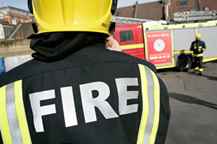Poor Turnout for Key Fire Services Meeting
Wandsworth stations safe may need to cover wider area
A public meeting was held last week (4th April) to brief the public on the changes proposed for the local fire service under the Draft Fifth London Safety Plan (2013-2016).
The meeting, which was chaired by DAC Richard Mills of the London Fire Brigade, heard how a sharp fall in the number of fires across the capital is to lead to the closure of 12 stations. Incidents of fires in the home are down significantly, compared to 10 years ago, mainly due to higher building standards, smoke alarms, sprinkler systems etc. Although Wandsworth and Battersea Fire stations are to remain open they are likely to have to deal with fires in a wider area with the closure of Clapham's station.
In 2011/2012 the Fire Brigade attended over 60,000 emergency incidents, and nearly 56,000 false alarms. There is a high level of false alarms, many of which come from automatic systems in non-domestic buildings. The Fire Brigade would like some form of payment to be considered when they have to attend false alarms to encourage owners of premises to have alarms better. There were fewer than 7,000 fires in the home, which the lowest level since records began in 1965. There were 33 deaths from fires in the home where the fire started accidentally. The Fire Brigade also attends about 10 road traffic accidents a day, assists when areas are flooded, and at other emergencies.
A female fire officer spoke passionately against the closure of any fire department and was vehemently opposed to the loss of any officers. Not only do they fight fires, rescue people, attend accidents, but also do community work putting up smoke alarms, and talking to/helping the vulnerable. She acknowledged Wandsworth was fortunate not to be losing any fire stations, but was greatly concerned that surrounding boroughs that are losing them will require more assistance from Wandsworth, and that they’ll be spread too thinly.
Senior officers said that they were very happy with the Plan and could see the changes that had occurred in the decrease in fires, the increase in prevention etc. meant that they could make these cuts safely.
There was some discussion on the dais as to whether or not it was the need for cuts were the fault of the previous Labour Government, and whether or not Mayor Boris Johnson was going to take any notice of what the consultation results were.
There was a poor turnout at the meeting. Putney resident Victoria Diamond attended and said, "I was disappointed at the small attendance of such an important meeting. There were approximately 20 residents plus several Councillors and local MPs, as well as representatives from the Fire Department. Publicity was not good – several attendees complained that they had only heard about the consultation meeting on the morning of the 4th. The Fire Department should have accessed Neighbourhood Watch Groups, Resident Associations, Amenity Groups, internet forums etc to spread the word."
London Assembly Member Richard Tracey was also at the meeting. He said, "I was happy to see that there would be no station closures nor removal of fire engines in Wandsworth, so Labour politicians’ scaremongering seemed baseless. I was impressed by the level of detail in the plan; it was evident that the senior fire officers had rigorously looked at the effects the modest reductions of stations and fire engines will have on fire cover across London.
"The myth that reversing the Mayor’s 1p a day council tax cut would stop the need for station closures was quickly dispelled and the logic behind reducing the fire service by 10% while London suffers from 50% fewer fires was adequately explained. "
He did question the value of a public meeting on the issue in boroughs like Wandsworth that was not seeing any station closures. He said, "I wasn’t surprised to learn that this was the result of the Labour Group, backed by Lib Dem and Green politicians, insisting on meetings in every London borough, presumably so they can stand up in a virtually empty room and publicly undermine the plan for London’s safety. Apart from Labour's Navin Shah AM, there wasn't another single Labour, Lib Dem, or Green politician present."
The three year outlook plan was outlined at the meeting. This is focused on prevention, protection and response.
The plan for London:
1. Closure of 12 fire stations: Belsize, Bow, Clapham, Clerkenwell, Downham, Kinsgland, Knightsbridge, New Cross, Silvertown, Southwark, Westminster, Woolwich
2. The removal of the second fire engine from seven fire stations: Chelsea, Chingford, Hayes, Leyton, Leytonstone, Peckham, Whitechapel
3. The addition of a second fire engine at Hendon, Orpington, Stanmore and Twickenham.
4. The loss of 520 firemen. Reduce the number of officers providing operational cover from 35 to 30 per 24 hour shift and consider returning to duty system whereby off duty officers can be recalled in times of excessive demand.
This means the loss of 18 fire engines 12 fire stations and 520 staff - a reduction of 11% in staff numbers. London will still have 100 fire stations, 151 fire engines and 4584 staff.
The aim is to get the first fire engine on site in 5 minutes 36 seconds (15 seconds slower) and the second engine on site in 6 minutes 38 seconds (16 seconds slower). These targets are generally met in Wandsworth.
40% of the funding for London's Fire Service will come from central government with another 30% from the new system of retained business rates and the rest from the Mayor’s share of London council tax.
April 12, 2013
Related links
|
